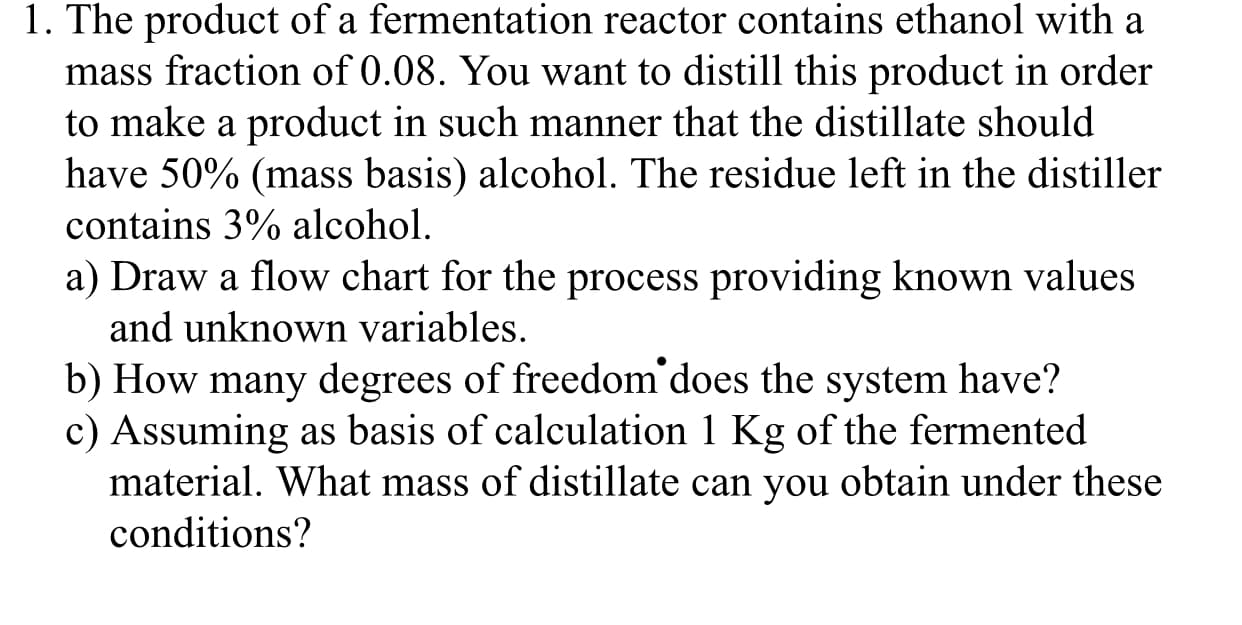1. The product of a fermentation reactor contains ethanol with a mass fraction of 0.08. You want to distill this product in order to make a product in such manner that the distillate should have 50% (mass basis) alcohol. The residue left in the distiller contains 3% alcohol a) Draw a flow chart for the process providing known values and unknown variables. b) How many degrees of freedom does the system have? c) Assuming as basis of calculation 1 Kg of the fermented material. What mass of distillate can you obtain under these conditions?
1. The product of a fermentation reactor contains ethanol with a mass fraction of 0.08. You want to distill this product in order to make a product in such manner that the distillate should have 50% (mass basis) alcohol. The residue left in the distiller contains 3% alcohol a) Draw a flow chart for the process providing known values and unknown variables. b) How many degrees of freedom does the system have? c) Assuming as basis of calculation 1 Kg of the fermented material. What mass of distillate can you obtain under these conditions?
Introduction to Chemical Engineering Thermodynamics
8th Edition
ISBN:9781259696527
Author:J.M. Smith Termodinamica en ingenieria quimica, Hendrick C Van Ness, Michael Abbott, Mark Swihart
Publisher:J.M. Smith Termodinamica en ingenieria quimica, Hendrick C Van Ness, Michael Abbott, Mark Swihart
Chapter1: Introduction
Section: Chapter Questions
Problem 1.1P
Related questions
Question

Transcribed Image Text:1. The product of a fermentation reactor contains ethanol with a
mass fraction of 0.08. You want to distill this product in order
to make a product in such manner that the distillate should
have 50% (mass basis) alcohol. The residue left in the distiller
contains 3% alcohol
a) Draw a flow chart for the process providing known values
and unknown variables.
b) How many degrees of freedom does the system have?
c) Assuming as basis of calculation 1 Kg of the fermented
material. What mass of distillate can you obtain under these
conditions?
Expert Solution
This question has been solved!
Explore an expertly crafted, step-by-step solution for a thorough understanding of key concepts.
This is a popular solution!
Trending now
This is a popular solution!
Step by step
Solved in 6 steps with 6 images

Recommended textbooks for you

Introduction to Chemical Engineering Thermodynami…
Chemical Engineering
ISBN:
9781259696527
Author:
J.M. Smith Termodinamica en ingenieria quimica, Hendrick C Van Ness, Michael Abbott, Mark Swihart
Publisher:
McGraw-Hill Education

Elementary Principles of Chemical Processes, Bind…
Chemical Engineering
ISBN:
9781118431221
Author:
Richard M. Felder, Ronald W. Rousseau, Lisa G. Bullard
Publisher:
WILEY

Elements of Chemical Reaction Engineering (5th Ed…
Chemical Engineering
ISBN:
9780133887518
Author:
H. Scott Fogler
Publisher:
Prentice Hall

Introduction to Chemical Engineering Thermodynami…
Chemical Engineering
ISBN:
9781259696527
Author:
J.M. Smith Termodinamica en ingenieria quimica, Hendrick C Van Ness, Michael Abbott, Mark Swihart
Publisher:
McGraw-Hill Education

Elementary Principles of Chemical Processes, Bind…
Chemical Engineering
ISBN:
9781118431221
Author:
Richard M. Felder, Ronald W. Rousseau, Lisa G. Bullard
Publisher:
WILEY

Elements of Chemical Reaction Engineering (5th Ed…
Chemical Engineering
ISBN:
9780133887518
Author:
H. Scott Fogler
Publisher:
Prentice Hall


Industrial Plastics: Theory and Applications
Chemical Engineering
ISBN:
9781285061238
Author:
Lokensgard, Erik
Publisher:
Delmar Cengage Learning

Unit Operations of Chemical Engineering
Chemical Engineering
ISBN:
9780072848236
Author:
Warren McCabe, Julian C. Smith, Peter Harriott
Publisher:
McGraw-Hill Companies, The